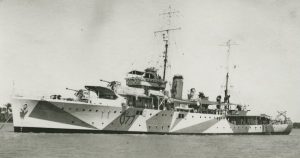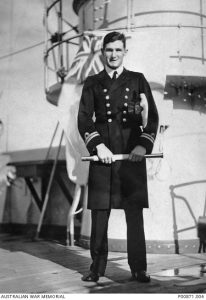- Author
- A.N. Other
- Subjects
- RAN operations, Ship histories and stories, WWII operations, History - WW2
- Tags
-
- RAN Ships
- HMAS Yarra II
- Publication
- June 2014 edition of the Naval Historical Review (all rights reserved)
By LCDR Desmond Woods, RAN
On 4 March this year the Governor General Her Excellency the Honourable Quentin Bryce, AC, CVO awarded a retrospective Unit Citation for Gallantry to HMAS Yarra II, a small sloop, lost to enemy action in March 1942. The ceremony was performed in Port Melbourne with her namesake HMAS Yarra IV moored close by and was also attended by relatives and close friends of the officers and men of Yarra II. A Unit Citation for Gallantry is awarded not to any individual but to an entire ship’s company and recognizes that every one of the crew acted in the face of the enemy above and beyond the call of duty and in the highest traditions of the Royal Australian Navy.

In early 1942 Yarra’s men through their actions earned for themselves and their little ship the deep respect and admiration of the generations of the RAN that have come after them. That is their triumph. They won this imperishable fame at a terrible cost to themselves and to their loved ones. That is our tragedy and that of their families. This courageous ship’s company deserves our national remembrance and our gratitude and the Governor General’s Citation for Gallantry recognizes this reality.
Yarra is remembered for the blaze of glory in which she was lost, but her whole wartime career was one of arduous and useful convoy escort work and deserves to be known. In particular on 5 February 1942, a month before Yarra fought her last fight, she was escorting troopships into Singapore under intense Japanese bombing. The converted liner Empress of Asia was hit amidships and uncontrollable fires broke out. Her two thousand five hundred troops needed to be rescued swiftly if a mass loss of life was to be avoided. Hundreds of soldiers dropped into the sea to avoid smoke and flame. Ships closed in to assist. It was the little Yarra, under her Commanding Officer CMDR Wilfred Hastings Harrington, that placed her bow to the stricken liner’s stern, manned her boats and lowered carley floats and rafts. Yarra’s crew rescued 1804 British soldiers from the water and the liner’s deck. With that number on his upper deck CMDR Harrington wrote ‘I was becoming a little dubious of the stability of my ship and on getting clear gave orders for all hands to sit.’ Finally through the skill of Yarra, Wollongong and Bendigo, only 30 men were lost on the Empress of Asia. This feat of professional seamanship would be remarkable in peacetime. Yarra achieved this rescue while under air attack. Indeed, Yarra’s gunners, with their ship a stationary target, fired back at their attackers and shot down at least one aircraft, probably two more, and drove off many others. Yarra’s sailors had all lived up to the highest ideals of conduct for the Navy. CMDR Harrington, wrote of them “my officers and men performed their various tasks with that coordination and cooperation which they are accustomed to show in unforeseen circumstances”. He singled out Leading Seaman Ronald ‘Buck’ Taylor’s conduct. “The Captain of No 2 gun deserves commendation in that on this occasion, as on many others, he controlled his gun with judgment and determination. His keenness and courage are an example to all those in his vicinity.”
Courage, skill and luck combined that day to give Yarra’s ship’s company a victory against the odds and a quiet satisfaction that they had saved life in an exemplary manner in circumstances of utmost danger to themselves.

(as Lieutenant) – AWM
Luck ran out for the little ship at dawn on 4 March when Yarra, under her new CO LCDR Robert William Rankin, found herself and her convoy trapped by no fewer than three Japanese 8-inch cruisers and two destroyers. There could be no escape and Rankin must have known it. The odds were impossibly weighted against Yarra and the convoy. Nevertheless, LCDR Rankin had a choice as to whether he would try to scatter under a smoke screen with his convoy or place his ship between the merchant men and the attackers and lay down a screen of smoke for them to flee behind. He chose the path of duty. He ordered the helm hard over towards the enemy and worked up to his best speed of 14 knots. He was trying to save his convoy by drawing the enemy’s fire and to close the range so that his 4-inch gun’s crews could have a go at hitting the cruisers. If ever a little ship and her Captain died fighting it was Yarra. Rankin’s sublime courage in fighting for his convoy is now widely regarded as one of the finest moments in the century long story of the nation and its navy.
The Japanese cruiser Maya brought up onto her deck the survivors of the British destroyer HMS Stronghold to witness the end of Yarra and her convoy. They saw that Yarra was being repeatedly hit by shellfire, but they also reported seeing ‘odd gun flashes’ as one of her 4-inch guns was still being fired. One of Stronghold’s men wrote that they were all moved by what they saw and were ‘vividly impressed’ by the fight that Yarra put up. We know that the gun flashes came from Leading Seaman Taylor. He told his gun’s crew to obey the general abandon ship order but chose to stay at his post. He then single handedly performed the lonely tasks of loading, aiming, firing and clearing his gun. Survivors reported that he scored at least one hit on the leading cruiser. He fired until Yarra was torn apart by shell fire and sank. He made his choice and died at his gun. His calmness and defiant courage that morning was typical of him and of the whole ship’s company.
The ordeal by thirst, exhaustion and exposure endured by those few who survived the sinking is harrowing. Thirty four men left the ship and only thirteen survived to be picked up by a Dutch submarine. They all have our profound admiration and respect.
Robert Rankin’s name lives on in the Navy in the Collins class submarine named for him. His sword and medals have a place of honour in the Royal Australian Naval College where he was educated and trained. His story and that of his men is told to every officer in the College as an enduring example of fidelity to duty.
Though we fervently trust that we shall never again be required to place our ships and our people in mortal danger that is always a hope, not a guarantee. Indeed every month of every year Navy people are required to act with courage and show endurance in the face of a variety of challenges. These young men and women are upholding our Navy values, which they know connect us with the heroic generations which forged those links with their lives in battle. Yarra’s story of fidelity and courage is an inspiration to today’s serving Navy people, as it will be to future sailors and officers down the decades and centuries yet to come. Yarra’s last fight has become the ‘gold standard’ for the conduct of our sailors wherever they are working and serving Australia.
Yarra’s men are not forgotten by the RAN and the nation and they never will be. May they rest in peace. Lest we forget.




